1-5 The Moon appears to change its position in the sky hourly and its phase throughout each month
 Go to Video 1-4
Go to Video 1-4
As seen from Earth, both the Sun and the Moon appear to move from west to east on the celestial sphere—that is, relative to the background of stars. They move at very different rates, however. The Sun takes one year to make a complete trip around the imaginary celestial sphere along the path we call the ecliptic. By comparison, the Moon takes only about four weeks. In the past, these similar motions led people to believe that both the Sun and the Moon orbit around Earth. We now know that only the Moon orbits Earth, while the Earth-Moon system as a whole (Figure 1-20) orbits the Sun. (In Chapter 4 we will learn how this was discovered.)
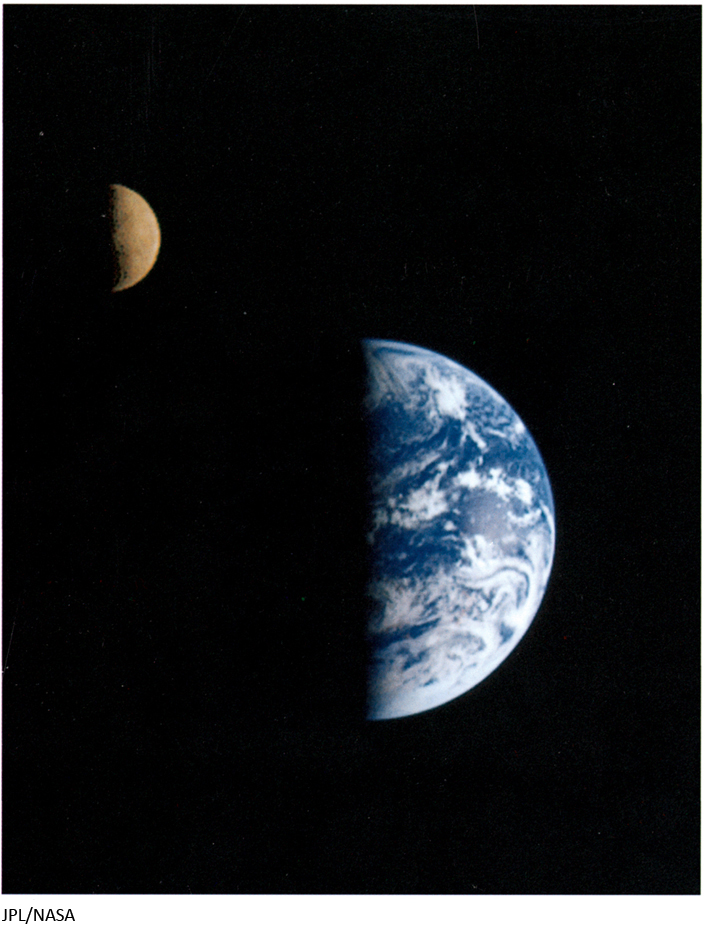
One key difference between the Sun and the Moon is the nature of the light that we receive from them. The Sun emits its own light. So do the stars, which are objects like the Sun but much farther away, and so does an ordinary lightbulb. By contrast, the light that we see from the Moon is reflected light. This is sunlight that has struck the Moon’s surface, bounced off, and ended up in our eyes here on Earth.
CAUTION
You probably associate reflection with shiny objects like a mirror or the surface of a still lake. In science, however, the term refers to light bouncing off any object. You see most objects around you by reflected light. When you look at your hand, for example, you are seeing light from the Sun (or from a light fixture) that has been reflected from the skin of your hand and into your eyes. In the same way, moonlight is really sunlight that has been reflected by the Moon’s surface.
Understanding the Moon’s Phases
Figure 1-20 shows both Earth and the Moon as seen from a spacecraft. When this image was recorded, the Sun was far off to the right. Hence, only the right-hand hemispheres of both worlds were illuminated by the Sun; the left-hand hemispheres were in darkness and are not visible in the picture. In the same way, when we view the Moon from Earth, we see only the half of the Moon that faces the Sun and is illuminated. However, not all of the illuminated half of the Moon is necessarily facing us. As the Moon moves around Earth, from one night to the next we see different amounts of the illuminated half of the Moon. These different appearances of the Moon are called lunar phases.
Figure 1-21 shows the relationship between the lunar phase visible from Earth and the position of the Moon in its orbit. For example, when the Moon is at position A, we see it in roughly the same direction in the sky as the Sun. Hence, the dark hemisphere of the Moon faces Earth. This phase, in which the Moon is barely visible, is called new moon. Since a new moon is near the Sun in the sky, it rises around sunrise and sets around sunset.
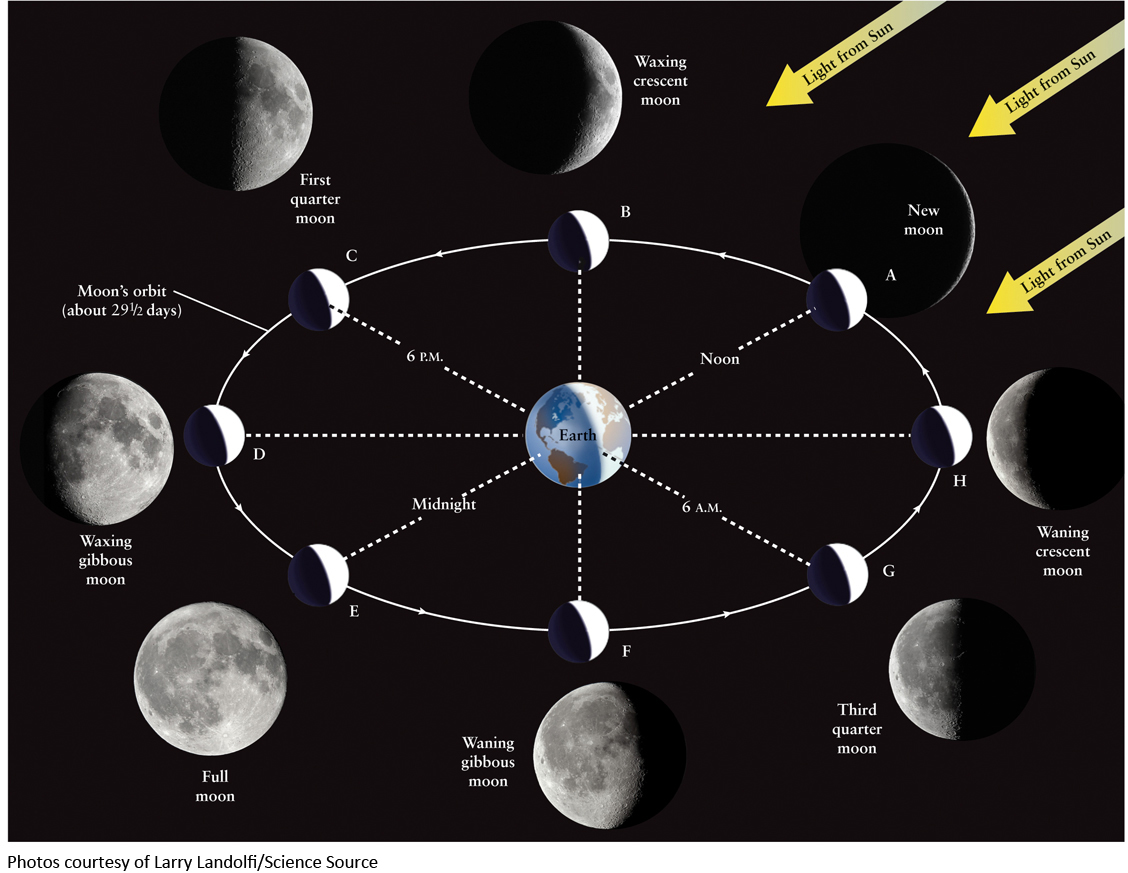
As the Moon continues around its orbit from position A in Figure 1-21, more of its illuminated half becomes exposed to our view. The result, shown at position B, is a phase called waxing crescent moon (“waxing” is a synonym for “increasing”). About a week after new moon, the Moon is at position C; we then see half of the Moon’s illuminated hemisphere and half of the dark hemisphere. This phase is called first quarter moon.
One half of our Moon is always lit by the Sun. The Moon’s phases are a result of our seeing more or less of the illuminated side.
As seen from Earth, a first quarter moon is one-quarter of the way around the celestial sphere from the Sun. It rises and sets about one-quarter of an Earth rotation, or six hours, after the Sun does: Moonrise occurs around noon, and moonset occurs around midnight.
18
CAUTION
Despite the name, a first quarter moon appears to be half illuminated, not one-quarter illuminated! The name means that this phase is one-quarter of the way through the complete cycle of lunar phases.
About four days later, the Moon reaches position D in Figure 1-21. Still more of the illuminated hemisphere can now be seen from Earth, giving us the phase called waxing gibbous moon (“gibbous” is another word for “swollen”). When you look at the Moon in this phase, as in the waxing crescent and first quarter phases, the illuminated part of the Moon is toward the west. Two weeks after new moon, when the Moon stands opposite the Sun in the sky (position E), we see the fully illuminated hemisphere. This phase is called full moon. Because a full moon is opposite the Sun on the celestial sphere, it rises at sunset and sets at sunrise.
Over the following two weeks, we see less and less of the Moon’s illuminated hemisphere as it continues along its orbit, and the Moon is said to be waning (“decreasing”). While the Moon is waning, its illuminated side is toward the east. The phases are called waning gibbous moon (position F), third quarter moon (position G, also called last quarter moon), and waning crescent moon (position H). A third quarter moon appears one-quarter of the way around the celestial sphere from the Sun, but on the opposite side of the celestial sphere from a first quarter moon. Hence, a third quarter moon rises and sets about one-quarter of an Earth rotation, or six hours, before the Sun: Moonrise is around midnight and moonset is around noon.
The Moon takes about four weeks to complete one orbit around Earth, so it likewise takes about four weeks for a complete cycle of phases from new moon to full moon and back to new moon. Since the Moon’s position relative to the Sun on the celestial sphere is constantly changing, the times of moonrise and moonset are different on different nights. On average, the Moon rises and sets about an hour later each night.
Figure 1-21 also explains why the Moon is often visible in the daytime, as shown in Figure 1-22. From any location on Earth, about half of the Moon’s orbit is visible at any time. For example, if it is midnight at your location, you are in the middle of the dark side of Earth that faces away from the Sun. At that time you can easily see the Moon at positions C, D, E, F, or G. If it is midday at your location, you are in the middle of Earth’s illuminated side, and the Moon will be easily visible if it is at positions A, B, C, G, or H. (The Moon is so bright that it can be seen even against the bright blue sky.) You can see that the Moon is prominent in the midnight sky for about half of its orbit and prominent in the midday sky for the other half.
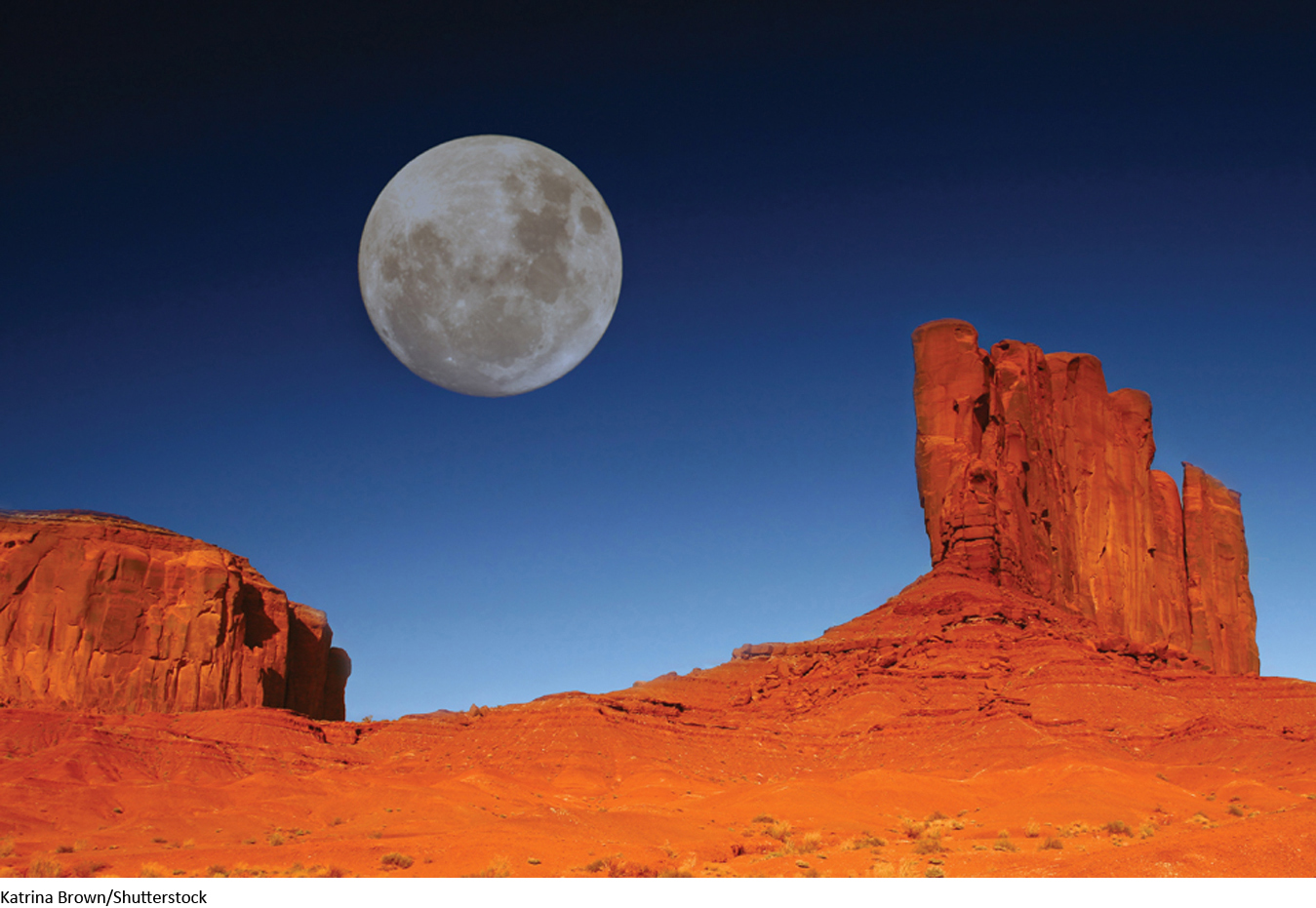
19
CAUTION
A very common misconception about lunar phases is that they are caused by the shadow of Earth falling on the Moon. As Figure 1-21 shows, this is not the case at all. Instead, phases are simply the result of our seeing the illuminated half of the Moon at different angles as the Moon moves around its orbit. To help you better visualize how this works, Box 1-2: Phases and Shadows describes how you can simulate the cycle shown in Figure 1-21 using ordinary objects on Earth. (As we will learn in Section 1-6, Earth’s shadow does indeed fall on the Moon on rare occasions. When this happens, we see a lunar eclipse.)
Although the phase of the Moon is constantly changing, one aspect of its appearance remains the same: It always keeps essentially the same hemisphere, or face, toward Earth. Thus, you will always see the same craters and mountains on the Moon, no matter when you look at it; the only difference will be the angle at which these surface features are illuminated by the Sun. (You can verify this by carefully examining the photographs of the Moon in Figure 1-21.)
THE HEAVENS ON EARTH
Phases and Shadows
Figure 1-21 shows how the relative positions of Earth, the Moon, and the Sun explain the phases of the Moon. You can visualize lunar phases more clearly by doing a simple experiment here on Earth. All you need are a small round object, such as an orange or a baseball, and a bright source of light, such as a street lamp or the Sun.
In this experiment, you play the role of an observer on Earth looking at the Moon, and the round object plays the role of the Moon. The light source plays the role of the Sun. Hold the object in your right hand with your right arm stretched straight out in front of you, with the object directly between you and the light source (position A in Figure B1-2.1). In this orientation the illuminated half of the object faces away from you, like the Moon when it is in its new phase (position A in Figure 1-21).

Now, slowly turn your body to the left so that the object in your hand “orbits” around you (toward positions C, E, and G in the illustration). As you turn, more and more of the illuminated side of the “moon” in your hand becomes visible, and it goes through the same cycle of phases—waxing crescent, first quarter, and waxing gibbous—as does the real Moon. When you have rotated through half a turn so that the light source is directly behind you, you will be looking face on at the illuminated side of the object in your hand. This corresponds to a full moon (position E in Figure 1-21). Make sure your body does not cast a shadow on the “moon” in your hand—that would correspond to a lunar eclipse!
As you continue turning to the left, more of the unilluminated half of the object becomes visible as it moves through the phases of waning gibbous, third quarter, and waning crescent. When your body has rotated back to the same orientation that you were in originally, the unilluminated half of your handheld “moon” is again facing toward you, and its phase is again new. If you continue to rotate, the object in your hand repeats the cycle of “phases,” just as the Moon does as it orbits around Earth.
The experiment works best when there is just one light source around. If there are several light sources, such as in a room with several lamps turned on, the different sources will create multiple shadows and it will be difficult to see the phases of your handheld “moon.” If you do the experiment outdoors using sunlight, you may find that it is best to perform it in the early morning or late afternoon, when shadows are most pronounced and the Sun’s rays are nearly horizontal.
20
Question
ConceptCheck 1-9: If an observer on Earth sees just a tiny sliver of the crescent moon, how much of the Moon’s total surface is being illuminated by the Sun?
Question
ConceptCheck 1-10: If the Moon appears in its waxing crescent phase, how will it appear in two weeks?
The Moon’s Synchronous Rotation
Why is it that we only ever see one face of the Moon? You might think that it is because the Moon does not rotate (unlike Earth, which rotates around an axis that passes from its north pole to its south pole). To see that this cannot be the case, consider Figure 1-23. This figure shows Earth and the orbiting Moon from a vantage point far above Earth’s north pole. In this figure two craters on the lunar surface have been colored, one in red and one in blue. If the Moon did not rotate on its axis, as in Figure 1-23a, at some times the red crater would be visible from Earth, while at other times the blue crater would be visible. Thus, we would see different parts of the lunar surface over time, which does not happen in reality.
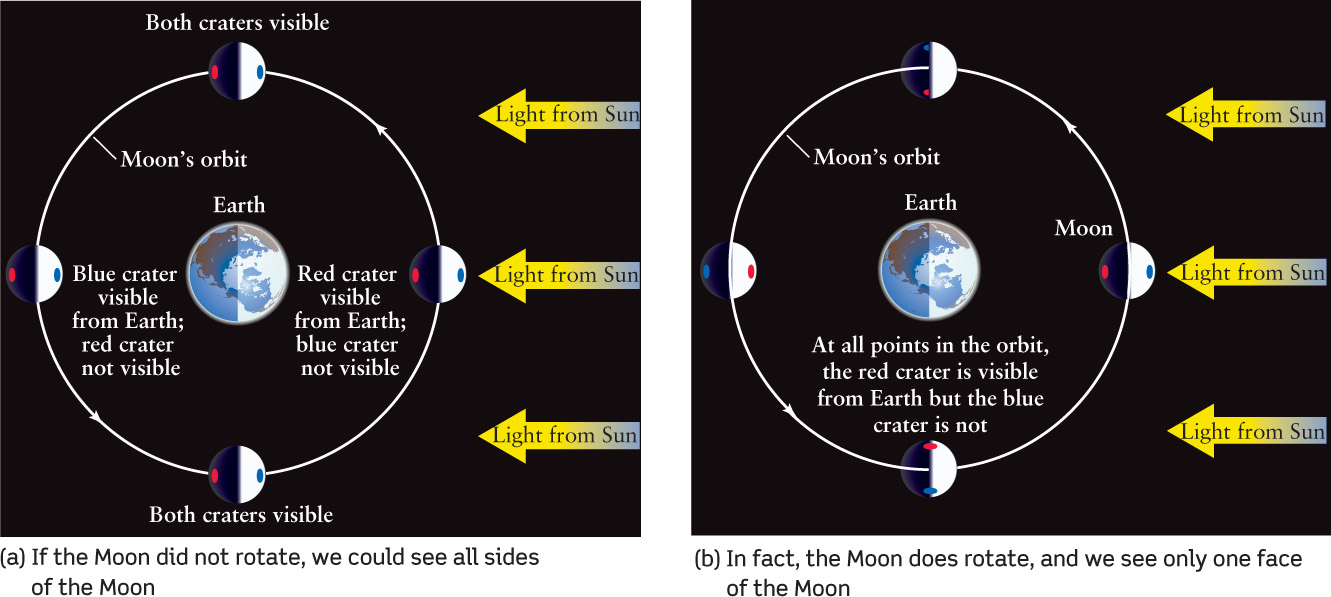
In fact, the Moon always keeps the same face toward us because it is rotating, but in a very special way: It takes exactly as long to rotate on its axis as it does to make one orbit around Earth. This situation is called synchronous rotation. As Figure 1-23b shows, this keeps the crater shown in red always facing Earth, so that we always see the same face of the Moon.
An astronaut standing at the spot shown in red in Figure 1-23b would spend two weeks (half of a lunar orbit) in darkness, or lunar nighttime, and the next two weeks in sunlight, or lunar daytime. Thus, as seen from the Moon, the Sun rises and sets, and no part of the Moon is perpetually in darkness. This means that there really is no “dark side of the Moon.” The side of the Moon that constantly faces away from Earth is properly called the far side. The Sun rises and sets on the far side just as on the side toward Earth. Hence, the blue crater on the far side of the Moon in Figure 1-23b is in sunlight for half of each lunar orbit.
Question
ConceptCheck 1-11: If astronauts landed on the Moon near the center of the visible surface at full moon, how many Earth days would pass before the astronauts experienced darkness on the Moon?
Sidereal and Synodic Months
 Go to Video 1-5
Go to Video 1-5
The time for a complete lunar “day”—the same as the time that it takes the Moon to rotate once on its axis—is about four weeks. (Because the Moon’s rotation is synchronous, it takes the same time for one complete lunar orbit.) It also takes about four weeks for the Moon to complete one cycle of its phases as seen from Earth. This regular cycle of phases inspired our ancestors to invent the concept of a month. For historical reasons, none of which has much to do with the heavens, the calendar we use today has months of differing lengths. Astronomers find it useful to define two other types of months, depending on whether the Moon’s motion is measured relative to the stars or to the Sun. Neither corresponds exactly to the familiar months of the calendar.
The sidereal month is the time it takes the Moon to complete one full orbit of Earth, as measured with respect to the stars. This true orbital period is equal to about 27.32 days. The synodic month, or lunar month, is the time it takes the Moon to complete one cycle of phases (that is, from new moon to new moon or from full moon to full moon) and thus is measured with respect to the Sun rather than the stars. The length of the “day” on the Moon is a synodic month, not a sidereal month.
The synodic month is longer than the sidereal month because Earth is orbiting the Sun while the Moon goes through its phases. As Figure 1-24 shows, the Moon must travel more than 360° along its orbit to complete a cycle of phases (for example, from one new moon to the next). Because of this extra distance, the synodic month is equal to about 29.53 days, about two days longer than the sidereal month.
21
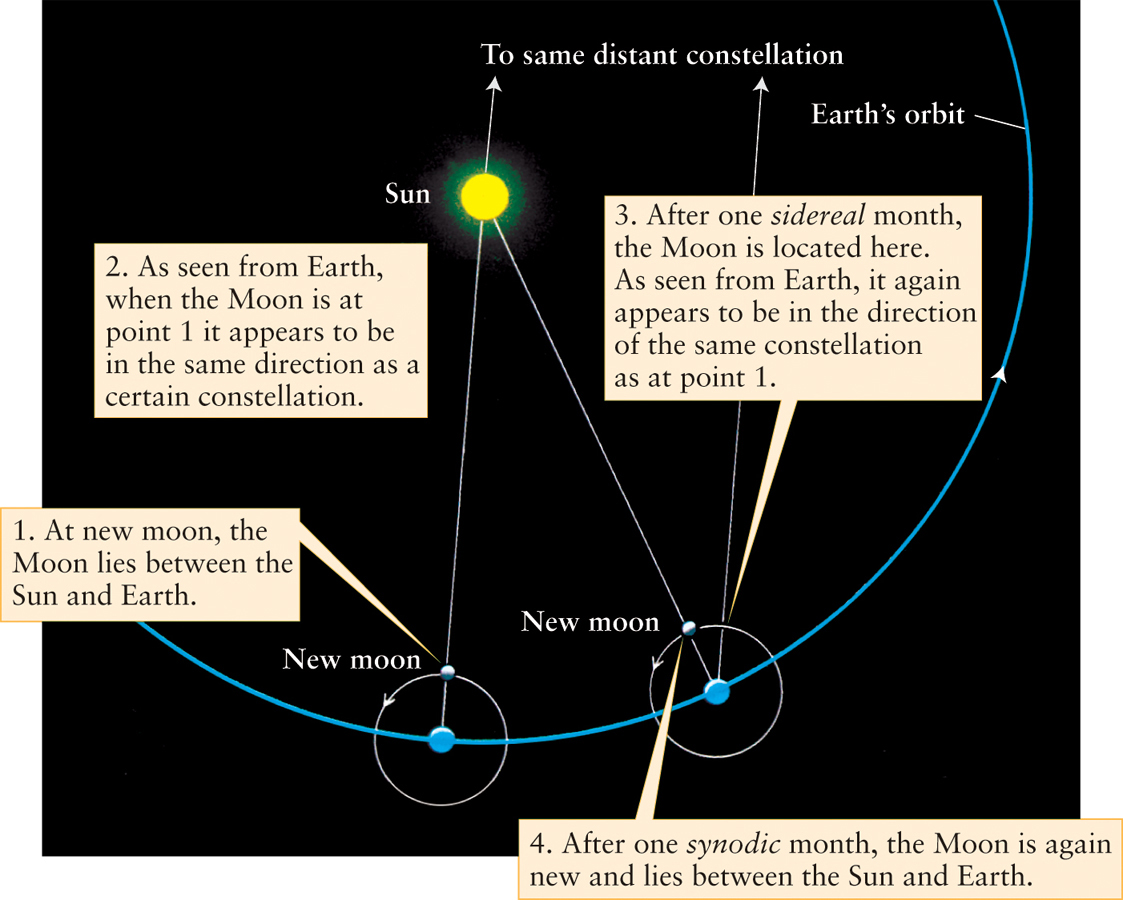
Both the sidereal month and synodic month vary somewhat from one orbit to another, the latter by as much as half a day. The reason is that the Sun’s gravity sometimes causes the Moon to speed up or slow down slightly in its orbit, depending on the relative positions of the Sun, Moon, and Earth. Furthermore, the Moon’s orbit changes slightly from one month to the next.
Question
ConceptCheck 1-12: If Earth was orbiting the Sun much faster than it is now, would the length of time between full moons increase, decrease, or stay the same?